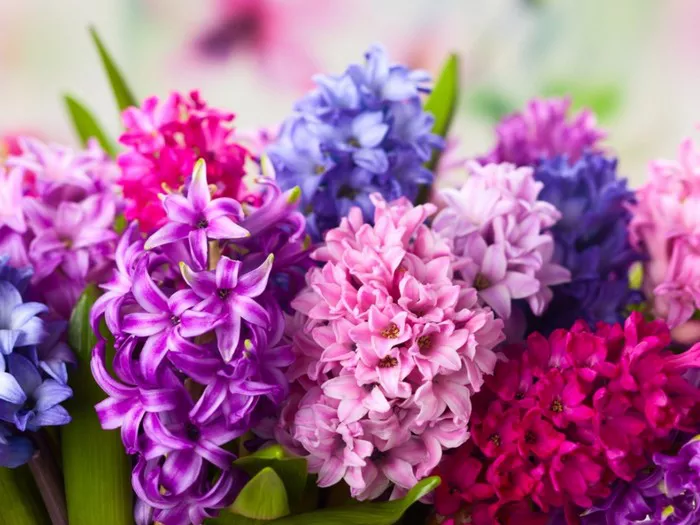Hyacinth flowers, with their vibrant colors and delicate blooms, are a popular choice for gardens, bouquets, and floral arrangements. These spring-flowering bulbs are known for their intoxicating fragrance and stunning appearance, making them a favorite among gardeners and florists alike. However, once the blooms have faded, many enthusiasts seek ways to preserve their beauty. Drying hyacinth flowers is a wonderful method to extend their lifespan and enjoy their charm long after the blooming season has passed.
Factors Affecting the Drying Effect of Hyacinth Flowers
Before delving into the methods of drying hyacinth flowers, it’s essential to understand the factors that can influence the drying process and the final result:
Stage of Bloom: The ideal time to harvest hyacinth flowers for drying is when they are in full bloom but have not yet started to wilt. Flowers that are too young may not retain their shape well, while those past their prime may lose their color and form during the drying process.
Humidity: Hyacinth flowers dry best in low humidity environments. Excess moisture in the air can prolong the drying time and may cause mold or mildew to develop on the flowers.
Air Circulation: Proper air circulation is crucial for the drying process. Flowers should be hung or placed in a well-ventilated area to ensure even drying and prevent the buildup of moisture.
Temperature: Moderate temperatures are optimal for drying hyacinth flowers. Extreme heat can cause the flowers to become brittle and lose their color, while cold temperatures may slow down the drying process.
Handling: Gentle handling is key to preserving the shape and integrity of hyacinth flowers during the drying process. Rough handling or excessive pressure can cause the petals to bruise or break.
Methods of Drying Hyacinth Flowers
There are several methods for drying hyacinth flowers, each with its own benefits and considerations:
Air Drying: Air drying is one of the simplest and most traditional methods of drying flowers. To air dry hyacinth flowers, gather them into small bunches and hang them upside down in a cool, dry, and dark location. Allow the flowers to dry for several weeks until they are completely crisp to the touch.
Silica Gel: Silica gel is a desiccant that absorbs moisture from flowers, making it an excellent choice for preserving their color and shape. To dry hyacinth flowers with silica gel, place the blooms in a container filled with silica gel and cover them completely. Seal the container and allow the flowers to dry for several days to a week, depending on their size and thickness.
Pressing: Pressing is a popular method for drying flowers that preserves their flat shape, making them ideal for crafts such as card-making and scrapbooking. To press hyacinth flowers, place them between layers of absorbent paper, such as blotting paper or newspaper, and place heavy books or weights on top. Allow the flowers to dry for several weeks, replacing the paper as needed until they are completely dry.
Microwave Drying: Microwave drying is a quick and convenient method for drying flowers, but it requires careful monitoring to prevent overheating and damage. To microwave dry hyacinth flowers, place them between two layers of paper towel and microwave them in short bursts of 30 seconds to one minute until they are dry to the touch.
Tips for Drying Hyacinth Flowers
To achieve the best results when drying hyacinth flowers, consider the following tips:
Harvest at the Right Time: Choose hyacinth flowers for drying when they are in full bloom but have not yet started to wilt. Flowers that are too young may not dry properly, while those past their prime may lose their color and form during the drying process.
Handle with Care: Handle hyacinth flowers gently to avoid bruising or damaging the petals. Use soft, gentle movements when gathering and arranging the flowers for drying.
Provide Adequate Ventilation: Ensure proper air circulation during the drying process by hanging or placing the flowers in a well-ventilated area. This will help prevent the buildup of moisture and promote even drying.
Monitor Temperature and Humidity: Keep an eye on the temperature and humidity levels in the drying area to ensure optimal conditions for the drying process. Avoid extreme temperatures and high humidity, as these can negatively impact the quality of the dried flowers.
Patience is Key: Drying hyacinth flowers takes time, so be patient and allow the flowers to dry thoroughly before handling or using them in arrangements. Rushing the process can result in subpar results and may cause the flowers to become brittle or discolored.
By following these guidelines and techniques, you can successfully dry hyacinth flowers and preserve their beauty for months to come. Whether you’re creating dried flower arrangements, crafting homemade gifts, or simply looking to extend the lifespan of your favorite blooms, drying hyacinth flowers is a rewarding and enjoyable process that allows you to enjoy their charm long after the blooming season has passed.
Conclusion
In conclusion, drying hyacinth flowers is a wonderful way to extend the beauty and enjoyment of these exquisite blooms long after their brief blooming season has passed. By understanding the factors that affect the drying process, choosing the right method for your needs, and following simple tips for success, you can preserve the vibrant colors, delicate shapes, and intoxicating fragrance of hyacinth flowers for months to come.
Whether you’re creating dried flower arrangements to adorn your home, crafting personalized gifts for loved ones, or simply seeking to capture the fleeting beauty of spring, drying hyacinth flowers offers a rewarding and satisfying experience. So, roll up your sleeves, gather your blooms, and embark on a journey to preserve nature’s beauty in all its splendor. With patience, care, and a touch of creativity, you can transform fresh hyacinth flowers into timeless treasures that will be cherished for years to come.


